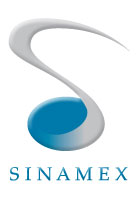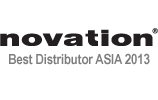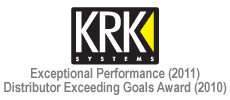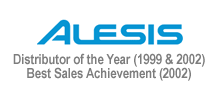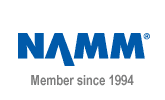Even if you have already made the plunge into digital recording, reading this can help you better understand how your gear works and identify ways you can improve your studio. So we hope you enjoy reading this.
Understanding the Basics
To fully understand digital audio technology,consider how the analog recording processworks: Microphones pick up sound waves, whichare converted to electrical energy and sent toa tape recorder. The tape recorder then stores these electrical signals on magnetic tape,allowing the recorded sounds to be played backand stored.The digital recording process is similar,except that instead of being stored onmagnetic tape, the electrical signals passthrough an analog-to-digital converter and arestored as data on a hard disk drive. Today'sdigital audio workstation software, such as Pro Tools, Ableton Live, Propellerheads Record, Garageband, etc. can emulate many aspects of the analog process, including multitrack recording,tape compression, track editing, punchrecording, direct monitoring and more. The keydifference is that expensive analog gear can now be replaced by an affordable digital studio - with an audio interface as its centerpiece.
Why do I Need an Audio Interface?
Most of today's computers feature a built-in sound card for connecting speakers, headphones and perhaps even a microphone to your computer. Although sound cards may be sufficient for listening to music, they typically lack the high-quality components and flexible connection options that you need for professional-level recording. If you're serious about music production, you're going to need a dedicated audio interface. An audio interface serves several purposes: First, it allows you to connect microphones, instruments and line-level gear. Second, it converts the incoming analog audio signals to digital audio data and sends the information to your host computer. And finally, on playback it converts digital audio from your computer back to analog signals that can be heard over speakers or headphones.
Choices, Choices, Choices
A quick web search or visit to your local music store will reveal that there are many, many audio interfaces from which to choose. Maybe you have wondered:
How many inputs and outputs do I need?
What’s the difference between USB and FireWire?
Why do some interfaces sound great while others don’t?
What makes a good preamp?
What’s the deal with different sample rates?
As you spend time reading about the different options available, make a list of features that are important to you. Your goal should be to find an interface that matches your requirements and gives you the functionality you need to produce music.
What Are You Planning To Record?
More than any other factor, this is going to decide which interface is best for you. Vocalists, solo musicians, DJs, hip-hop producers, electronic performers and bands all have different needs when it comes to recording. In order to select an interface that will stand the test of time, it's wise to consider what projects you are currently working on - as well as what studio endeavors you might explore in the future.
Analog Inputs
Choosing the right number of inputs and outputs is perhaps the most important decision you have to make when selecting an interface, and it all depends on what you plan on recording. If you record just two tracks at a time - or if you produce music using strictly loops, samples and soft synths - a basic two-channel interface will be more than sufficient. Most audio interfaces feature standard XLR microphone inputs that allow you to record vocals and acoustic instruments using microphones. Recording drum kits usually necessitates at least four inputs, and tracking a live band requires a minimum of eight, each with individual mic preamps. Large-scale project studio owners will need an interface that offers flexible I/O options for connecting with a variety of outboard analog and digital equipment.
Line Inputs
The most common type of analog connections are called "line level," and are used to connect keyboards, synth modules, signal processors, CD players and other gear at a standardized signal level. Line level signals require amplification in order to have enough strength to be heard over speakers. You can use 1/4" line-level connections to hook up the outputs of an analog mixer to your audio interface. This allows you to utilize the mixer's preamps and EQ before sending the signals to your interface.Most guitars and basses, on the other hand, are basically simple transducers that don't even put out enough juice to attain line level. In order to record guitar, bass or other "high impedance" (Hi-Z) signals, you either need a direct box (DI) or an audio interface with one or more dedicated Hi-Z instrument inputs. An instrument input functions like a mini direct box, converting the high-impedance instrument signal to a level that can be handled by pro-level recording gear. This will enable you to record guitar or bass without using an amplifier - for which your neighbors will be grateful.
Microphone Preamps
Microphones also generate weak audio signals that must be amplified in order to match the level of recording gear. A preamp allows you to adjust the amount of gain and boost the microphone output signal to the desired level. Some preamps are designed to offer clean, transparent results - while others are meant to "color" the audio and provide a distinctive character to the sound. Either way, you want preamps that deliver high gain without introducing unwanted noise and hiss from their internal circuitry. This will allow you to achieve clean, natural sounding audio without having to crank the preamp all the way up. Switchable pads help you record exceptionally loud sources by decreasing the signal by a given amount, usually -20dB.
Signal-to-Noise Ratio
When comparing preamps, signal-to-noiseratio is one of the most important specsto consider. It indicates how much noise isintroduced by the preamps' internalcircuitry.The lower the ratio, the better. For example, asignal-to-noise ratio of -100dB indicates thatthe noise is -100dB quieter than the maximumlevel of gainbefore distortion.
About Phantom Power
All condenser microphones (except electrets) need DC power in order to operate properly. While some high-end and vintage microphones draw power from an external dedicated power supply, most condenser mics are designed to receive "phantom power" supplied by the preamp or mixing desk. Phantom power provides between 12 and 48 volts of power along the same XLR cable that carries the audio signal. If you plan on recording with condenser microphones, make sure to choose an interface that offers phantom power.
Analog Outputs
Since an audio interface processes sound outside of your computer, you'll need at least one pair of outputs to connect to active reference monitors or to a power amp and speaker system. Additional analog outputs are useful for routing audio to external gear like headphone amps, effects processors and mixing boards. For example, you could send a pair of outputs to an outboard reverb unit and feed the processed signal back into the interface inputs. Or you could assign each channelin your digital audio workstation (DAW) to its own individual output and route all your tracks through an analog mixer.
Using Studio Monitors
Although it is possible to monitor through a home stereo or desktop speakers, using dedicated studio monitors will yield much better performance from your setup. If your interface has multiple outputs, you can hook up several pairs of monitors and compare your mixes between them.
Headphone Outputs
Dedicated headphone outputs can come in very handy, especially in situations where you're unable to use studio reference monitors. Multiple headphone outputs are useful if you record with other musicians, and can save you the expense of purchasing a separate headphone amplifier. As mentioned later, software control panels can provide I/O control for creating different dedicated headphone mixes for each headphone output - such as a main mix plus a click track for a drummer.
Surround Sound Mixing
Nowadays, most music for video games, TV and film is mixed in surround sound. If you plan on doing multimedia work, get an interface with enough simultaneous outputs to drive a full surround sound system.
Digital I/O Options
If you own outboard gear that supports digital I/O (or if you plan on expanding your setup), it's good to have an interface that offers digital inputs and outputs. Transferring audio in the digital domain has several advantages. You avoid unnecessary conversions that can degrade the quality of your signal. You can send as many as eight digital audio signals over a single ADAT cable. And since digital audio is simply a series of zeros and ones, you never have to worry about setting levels or clipping the signal. There are several digital audio formats currently in widespread use, the most common are S/PDIF (Sony/Phillips Digital InterFace) and ADAT (Alesis Digital Audio Tape).
S/PDIF
The S/PDIF format is capable of sending a stereo audio signal over a single RCA-type or ADAT TOSLINK cable. Many effects processors, A/D-D/A converters, microphone preamps, CD players, keyboards and samplers support S/PDIF.
ADAT
The ADAT optical standard supports multitrack digital I/O over a fiber optic cable. A single ADAT port is capable of transferring either eight channels of 44.1/48kHz audio, four channels of 88.2/96kHz audio, or two channels of high-definition 192kHz audio. Many digital audio converters, digital mixers and multichannel preamps are ADAT-compatible.
MIDI I/O
MIDI, or Musical Instrument Digital Interface, is a communication protocol that enables electronic musical instruments, computers and other digital equipment to communicate and share data. Nearly all modern keyboards, synthesizers and DAW applications support MIDI. If you want to integrate synths, effects processors and other MIDI gear into your setup, look for an audio interface that offers at least one MIDI input and one MIDI output.
Word Clock
Your computer-based DAW stores and manipulates music as digital samples (more on sampling later). Each device in your interconnected digital world must share the same timing in order to communicate correctly - that is, their clocks must be synchronized. Word clock makes this possible by designating one device as the timing "master," and all other connected devices as "slaves," locking the slaves to the master. This ensures that all digital gear is running at a common sample rate.Without word clock, your digital audio signal will be filled with clicks and pops (if, in fact, it plays at all).
Connectivity Options - PCI, USB and FireWire
Once you have decided roughly how much analog and digital I/O you need, you should consider which connectivity option to use - USB, FireWire or PCI. Each format presents unique advantages and disadvantages. It all depends on what works best for your system.
USB 1.1
The vast majority of computers today come with USB ports, making USB audio interfaces an attractive option for musicians and producers.
USB 2.0
USB 1.1 is a good choice for working with two channels at once and creating CD-quality tracks. But when you want to record at higher sample rates and/or capture multiple channels at once, you need the increased data transfer speed offered by USB 2.0. USB 2.0 devices have become more common in recent years, and provide a stable, reliable solution for working with high-fidelity audio. To use a high-speed USB 2.0 recording device, all you need is a computer that supports USB 2.0.
FireWire
Like USB 2.0, FireWire offers the bandwidth necessary to record multiple tracks at high sample rates. But unlike USB 2.0, which transmits data in "packets," FireWire provides a continuous flow of data - allowing FireWire interfaces to process audio more efficiently. FireWire can be an especially attractive choice for Mac users, since many Apple computers come standard with the necessary port. Many PC manufacturers also include FireWire ports on their latest machines. If your PC doesn't support FireWire, you can always purchase and install a third-party card. FireWire comes in two flavors - FireWire 400 and FireWire 800. FireWire 400 is the industry-standard for audio interface technology, while FireWire 800 offers increased data transfer rates and is typically used for external hard drive enclosures. If your computer only has a FireWire 800 port, don't worry - all FireWire interfaces are fully compatible with both 400 and 800 ports. All you need is the proper cable (400 to 800) and you're good to go.
PCI
The third most common type of audio interface consists of a PCI hardware card placed directly into a slot on the motherboard. Some units feature audio connections on the card itself, while others offer a separate breakout box with analog and digital I/O. These interfaces provide tight integration with the host computer, which results in low latency and excellent MIDI timing. However, PCI-based interfaces must be installed inside a computer tower, so they're inherently less mobile.
Thunderbolt
With 12 times more bandwidth than FireWire 800 and 20 times more bandwidth than USB 2, Thunderbolt interfaces offer very low latency, high channel count and pristine high definition audio quality. PCI Express is the high-speed bus used inside computers and is one reason why internal computer cards have enjoyed a speed and efficiency advantage compared to external devices which communicate through FireWire or USB layers. With Thunderbolt, PCI Express-level performance can be taken outside the computer.
Audio Quality
Visit any online audio forum and you'll no doubt find a heated discussion about which audio interface sounds the best. Everyone seems to have a different opinionon the subject, so it's hard to separate fact from the fiction. One thing is for sure - when it comes to overall audio quality, internal components play a big role. But it's also important to select the right sample rate and bit depth for your project in order to capture the entire dynamic range of the performance.
Sample Rate Explained
A thorough discussion of digital audio sampling would probably encompass several volumes of text. However, it is possible to understand the basics with a brief overview… Digital audio interfaces sample analog audio signals and convert them to digital data. These individual samples are like quick "snapshots" of sound. A sample rate of 44.1kHz means that the audio interface takes 44,100 snapshots per second. A higher sample rate of 96kHz means that 96,000 samples per second are captured. Higher sample rates sound better because more information is captured. When the interface converts the digital data back to analog audio, the empty space between the samples is "smoothed over" (see figure). When recording at higher sample rates, there is less empty space between samples, which results in more accurate smoothing and better-sounding audio. Higher sample rates also capture a wider range of frequencies. While it's true that the human ear can't hear past 20kHz, there are harmonics and overtones that reach much higher into the frequency range. These harmonics, when captured by an interface running at 96kHzor higher, can impact the frequencies that we do hear.
Bit Depth Exposed
While the sample rate determines how often the interface captures audio, the bit depth determines how much information is captured by each sample. It's kind of like a digital photograph - an eight-megapixel photo captures more detail and has higher resolution than a three-megapixel shot. Likewise, 24-bit recordings capture better detail than 16-bit recordings (while 8-bit audio sampling should best be left to old-school Nintendo games!). Higher bit depths also allow you to capture a greater dynamic range and record hotter signals.
Selecting the Right Audio Quality
Many wonder why it's worth recording at high sample rates and bit depths - especially since those formats consume extra system resources and hard drive space. The answer depends on what's being recorded, as well as what the final output medium will be. If the final destination is CD, the audio will have to be downsampled to 16-bit/44.1kHz - at which point the extra information captured at 24-bit/96kHz will be lost. However, as mentioned earlier, those upper-range frequencies do impact what we hear in the lower bands. Recording at high sample rates can be especially beneficial when recording acoustic instruments, cymbals and other sources with high-frequency "air-like" qualities. Any EQ, effects and other processing will be done at a higher level of audio quality, resulting in better-sounding audio even when downsampled to CD format. If the final output will be on DVD, it's definitely a good idea to record at higher rates. DVDs, video games and other multimedia formats typically use far higher sample rates than standard CDs.
Internal Components - DACs Make a Big Difference
So why do some interfaces sound great while others don't - even when recording at equal sample rates and bit depths? The answer lies in the quality of internal components. Every interface contains internal digital audio converters (DACs) that convert incoming analog signals to digital data that can be read and stored. Theperformance of these components makes a huge impact on the quality of your recordings. When it comes to DACs, there are two key factors to consider: signal-to-noise ratio and internal clock stability. A low signal-to-noise ratio (S/N specs are expressed in negative values) means that the interface delivers a wide dynamic range without introducing much noise. Remember, unwanted noise can degrade the quality of your audio and ruin an otherwise good recording! The other factor that can impact digital audio conversion is clocking. Audio interfaces must sample at regular intervals in order to capture sound accurately. A poorly designed clock can cause the interface to sample audio irregularly, resulting in "jitter." So just because two audio interfaces are recording at the same sample rate and bit depth (let's say, 24-bit/48kHz) doesn't mean the results will sound the same. The quality of the internal components - and in particular, the DACs - makes a really big difference in performance.
Software Drivers
Some audio interfaces are class-compliant, meaning they are plug-and-play ready right out of the box. Most interfaces however, require specific software drivers inorder to operate efficiently with your computer and DAW software. Drivers are very important because they tell the computer how to communicate with your hardware.
Solving The Latency Problem
All digital audio systems introduce a certain amount of delay between input and output, otherwise known as "latency." Latency can present a challenge, especially when recording vocals - the singer hears his own voice "live," as well as the delayed, processed signal coming back from the DAW. The resulting delay makes it difficult to maintain proper pitch and timing. Hardware direct monitoring solves this problem by letting you monitor directly through the interface, before any latency is introduced by the host CPU. You just open the audio interface software control panel and select which live inputs and software returns you want to hear while recording. By monitoring your live inputs before they pass through the computer, you'll enjoy a more natural recording experience - just like when using a standard analog mixer.
Final Thoughts
Choosing the right interface can be a daunting task, especially if you're just getting started in the world of recording. As you spend time exploring the choices available to you, remember to select an interface that offers the following:
- The right amount of inputs and outputs High-quality preamps and digital converters
- Driver compatibility with your computer system
- The right computer connectivity format
Once you've found the ideal audio interface, you'll be well on your way to making great recordings and ready to explore the creative world of music production.
